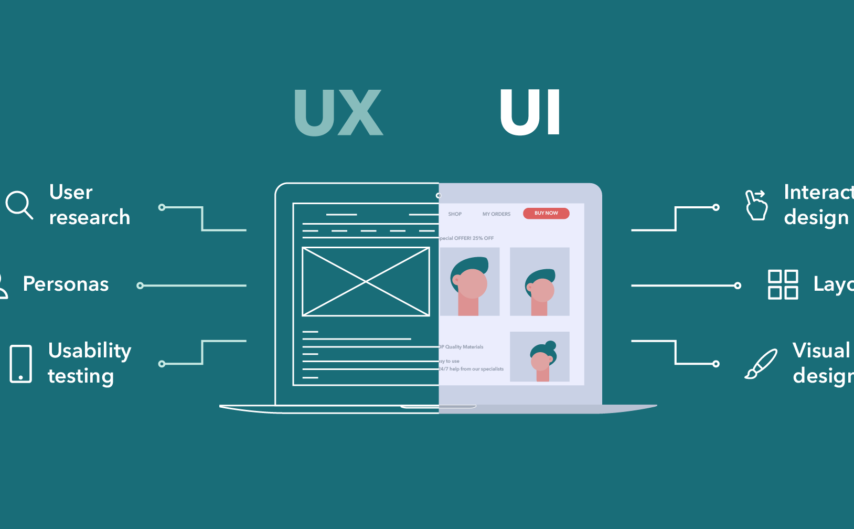The UX and UI designs are usually combined and confused when it comes to app and web design. Both of them often fall under the same single term. Let us take a look into what these terms specifically mean:
What Is UX Design?
UX is also called “User Experience.” It lays emphasis on the user’s experience with a specific application. The user experiences heavy stress on the user’s interaction. It’s all about examining whether the experience on a specific app is smooth or confusing. The User Experience tends to be determined by how hard or easy it is in interacting with UI elements, which the UI designers made.
Here, some of the questions that you need to ask yourself include:
- Is the navigation inside the app erratic or logical?
- Are the users completing their tasks efficiently, or are they finding it a struggle for the most part?
What Is UI Design?
UI is also known as User Interface. Here, the UI is referring to an application’s graphical layout. It includes the texts that user reads, the buttons that they click on, the text entry fields, sliders, pictures, and the remaining stuff that they interact with. It is also referring to the screen layout, interface animations, every micro-interaction, and transitions.
Any visual element, animation, or interaction should be designed. Here, the UI designers get to decide on how the app will look like. Everything is up to them, from text fonts used to color schemes to the width of lines to button shapes. They are responsible for creating the feel and appearance of an app’s user interface.
UX & UI In Top Dating Apps
Let us examine these aspects of app design side by side with Tinder & Bumble.
Login & Registration
Both of these dating apps provide a simple and convenient registration/login process. Their designs are minimal and don’t come with tons of user interface elements. But there are variations concerning the user flow in both of these apps. For instance, Tinder begins by sharing and showing basic guidelines, which are also called house rules. It does so while utilizing the application in the instant screen itself right after you log in. But Bumble tends to place it as their final step during the registration/login process. Both Tinder and Bumble tend to gather basic data such as Name, Sexual Orientation, DOB, and Gender.
They also go that extra mile of offering the option to pick their gender identity and how to identify themselves. Here, Tinder also gives the option of choosing from three sexual orientation types, i.e., “Men/Women/Everyone.” However, this feature isn’t present on Bumble. Tinder also utilizes active wording such as “My first name is….” It assists in creating a sort of convo with the user. You will also come across a progress bar, which indicates the duration of the procedure.
Profile Set-Up
Certain free sex websites that focus on casual dating with an emphasis on anonymity, don’t require photos on profiles. However, almost any mainstream dating app would require you to upload a photo for your profile picture. But with Tinder, you have to add at least two photos at a minimum. Tinder also requires you to upload pictures from your recent photos, which can consume some time to pick, especially when you have tons of random photos from your recent section. On the other hand, Bumble possesses all the required functionalities that you can expect when you are going to upload a photo. With Bumble, you can easily upload any files.
Moreover, Tinder requires you to pick up to five passions at maximum. You can choose these passions from the list it gives you, which allows you to locate people with similar likes and interests. The last step involves Tinder asking you if you wish to avoid someone on the app. It does so by sharing your personal contact list. In this way, both parties won’t be seeing one another on there. This feature is quite useful, especially if you want to avoid an ex, a friend, or family members in the app.
Just like any other dating app, Bumble and Tinder also require you to turn on your location. Here, they will ask your permission to activate location services, which are needed to meet people in the vicinity. Tinder also has a grey button titled “Tell me more,” which will lead you to a different screen. It explains the reasons why you should enable location services for certain benefits. You will have an easier time locating and swiping people nearby.
Getting Started
Next, you will come across a short and useful tutorial on both these apps. You will see the picture of your first possible match in the form of a card. The design of Tinder’s match is quite simple, containing only photos, name, passion tags, age, and 1-line description. You will also come across users with verified badges. As you proceed to scroll the card, extra information such as location, Instagram account, kilometers away, and Spotify interests can be seen.
But Bumble’s card is way simpler, containing only name, age, and photos. You will come across the next tutorial once you tap on the card. However, your actions are undoable unless you possess a premium account. If you end up swiping left on someone, then they are gone forever. After you successfully pair up with someone, you can start chatting with them in the inbox.
Inbox
Tinder recently introduced a new feature titled “My Move.” It offers women additional security by allowing them to initiate the conversation. However, this feature isn’t turned on through default. But Tinder also has certain limitations. You can only send regular texts, GIFs, and start video calls. Most people end up exchanging digits and messages through other messaging channels.
Bumble allows you to say Hi by using GIFs or asking random questions. Bumble also enables you to take snaps, send voice messages, make a video or phone call without exchanging digits. It also provides the “Accept or Not” option to prevent harassment. You won’t be receiving undesirable pictures of strangers without your consent.
Profile Verification & Filters
Both Tinder and Bumble prevent users from catfishing. The apps require you to click a picture of yourself and proceed to analyze it using facial recognition. Tinder also enables you to insert pictures and videos on your profile; however, it is only limited to “Capture from camera” or “Recent photos.” In Bumble, you can filter your matches for locating people with similar interests.
You can also choose which filters you want to display on your profile. In this way, you can remove people that don’t meet your criteria on Bumble. It includes filters like height, exercise, zodiac, education level, drinking, smoking, etc. However, Tinder doesn’t come with this feature. The only filter in Tinder that you can make use of includes the age gap and distance.
Summing It Up!
The UI and UX of these dating apps are minimalistic and convenient. There is always room for improvement but for the most part; it gets the job done. Millions and millions of people across the globe use these apps for relationships, friendships, hookups, networking, and even for work purposes. Their user interface and user experience are constantly improving with each update.







